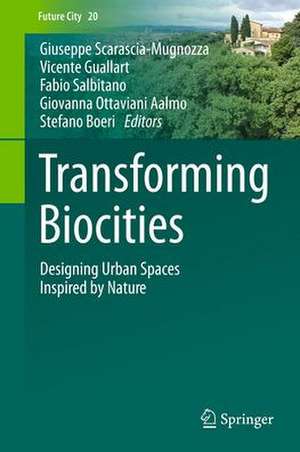Transforming Biocities: Designing Urban Spaces Inspired by Nature: Future City, cartea 20
Editat de Giuseppe E. Scarascia-Mugnozza, Vicente Guallart, Fabio Salbitano, Giovanna Ottaviani Aalmo, Stefano Boerien Limba Engleză Hardback – 7 iul 2023
Placing nature at the forefront of city planning is not an entirely new concept, so the authors build on established ideas like the garden city, green city, eco-city, or smart city. All chapters aim to highlight aspects to develop a city that is a resilient nature-based socio-ecological system. Many of these concepts were formed in an effort to copy the best traits of a forest ecosystem: a home for many different species that build complex communities. Much like many of our forests, urban areas are managed by humans for multifunctional purposes, using living and abiotic components. This viewpoint helps to understand the potential and limitations of sustainable growth.
With these chapters, the authors want to inspire planners, ecologists, urban foresters and decision makers of the future.
| Toate formatele și edițiile | Preț | Express |
|---|---|---|
| Paperback (1) | 928.85 lei 38-44 zile | |
| Springer International Publishing – 7 iul 2024 | 928.85 lei 38-44 zile | |
| Hardback (1) | 1114.83 lei 6-8 săpt. | |
| Springer International Publishing – 7 iul 2023 | 1114.83 lei 6-8 săpt. |
Din seria Future City
-
 Preț: 330.12 lei
Preț: 330.12 lei - 15%
 Preț: 641.85 lei
Preț: 641.85 lei - 18%
 Preț: 958.73 lei
Preț: 958.73 lei - 18%
 Preț: 966.27 lei
Preț: 966.27 lei - 24%
 Preț: 622.87 lei
Preț: 622.87 lei - 23%
 Preț: 846.68 lei
Preț: 846.68 lei - 24%
 Preț: 784.55 lei
Preț: 784.55 lei - 23%
 Preț: 567.55 lei
Preț: 567.55 lei -
 Preț: 371.97 lei
Preț: 371.97 lei - 19%
 Preț: 553.69 lei
Preț: 553.69 lei - 24%
 Preț: 871.41 lei
Preț: 871.41 lei - 24%
 Preț: 833.99 lei
Preț: 833.99 lei - 18%
 Preț: 954.14 lei
Preț: 954.14 lei - 18%
 Preț: 949.42 lei
Preț: 949.42 lei - 18%
 Preț: 1243.29 lei
Preț: 1243.29 lei - 18%
 Preț: 950.21 lei
Preț: 950.21 lei - 15%
 Preț: 647.59 lei
Preț: 647.59 lei - 20%
 Preț: 516.80 lei
Preț: 516.80 lei - 24%
 Preț: 897.13 lei
Preț: 897.13 lei
Preț: 1114.83 lei
Preț vechi: 1359.55 lei
-18% Nou
Puncte Express: 1672
Preț estimativ în valută:
213.35€ • 221.92$ • 176.13£
213.35€ • 221.92$ • 176.13£
Carte tipărită la comandă
Livrare economică 14-28 aprilie
Preluare comenzi: 021 569.72.76
Specificații
ISBN-13: 9783031294655
ISBN-10: 3031294653
Ilustrații: X, 304 p. 59 illus., 54 illus. in color.
Dimensiuni: 155 x 235 mm
Greutate: 0.62 kg
Ediția:2023
Editura: Springer International Publishing
Colecția Springer
Seria Future City
Locul publicării:Cham, Switzerland
ISBN-10: 3031294653
Ilustrații: X, 304 p. 59 illus., 54 illus. in color.
Dimensiuni: 155 x 235 mm
Greutate: 0.62 kg
Ediția:2023
Editura: Springer International Publishing
Colecția Springer
Seria Future City
Locul publicării:Cham, Switzerland
Cuprins
Towards the Development of a Conceptual Framework of BioCities.- Urban sustainable futures: concepts and policies leading to BioCities.- Biodiversity and Ecosystem Functions as Pillars of BioCities.- Green Infrastructure and Urban Forests for BioCities: Strategic and Adaptive Management.- Mitigation and Adaptation for Climate Change: The Role of BioCities and Nature Based Solutions.- BioCities as Promotors of Health and Wellbeing.- Forests, Forest Products and Services to Activate a Circular Bioeconomy for City Transformation.- Innovative Design, Materials, and Construction Models for BioCities.- The Social Environment of BioCities.- From BioCities to BioRegions and Back: Transforming Urban-Rural Relationships.- The Enabling Environment for BioCities.- Towards BioCities – The Pathway to Transition.
Textul de pe ultima copertă
This edited volume centers around the concept of BioCities, which aim to unify nature and urban spaces in order to reverse the effects of global climate change and inequity. Following this principle, the authors propose multiple approaches for sustainable city growth. The discussed concepts are not only relevant for newly constructed cities, but offer transformative perspectives for existing settlements as well.
Placing nature at the forefront of city planning is not an entirely new concept, so the authors build on established ideas like the garden city, green city, eco-city, or smart city. All chapters aim to highlight aspects to develop a city that is a resilient nature-based socio-ecological system. Many of these concepts were formed in an effort to copy the best traits of a forest ecosystem: a home for many different species that build complex communities. Much like many of our forests, urban areas are managed by humans for multifunctional purposes, using living and abiotic components. This viewpoint helps to understand the potential and limitations of sustainable growth.
With these chapters, the authors want to inspire planners, ecologists, urban foresters and decision makers of the future.
With these chapters, the authors want to inspire planners, ecologists, urban foresters and decision makers of the future.
Caracteristici
Proposes new concepts for urban planning with nature-based solutions Highlights Biocities as part of a circular Bioeconomy Relevant for the UN's Sustainable Development Goal SDG 11: Sustainable Cities and Communities
